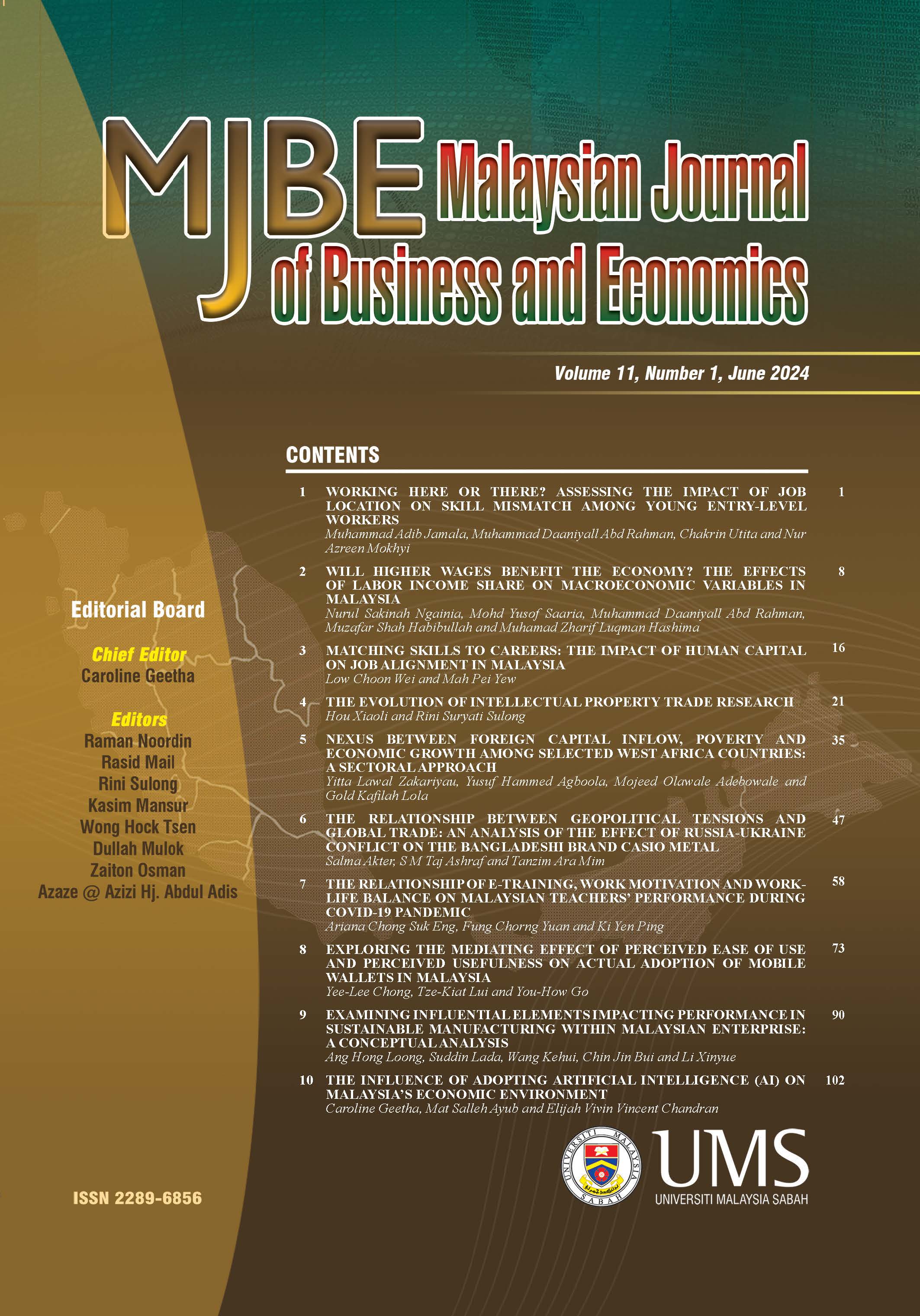WORKING HERE OR THERE? ASSESSING THE IMPACT OF JOB LOCATION ON SKILL MISMATCH AMONG YOUNG ENTRY-LEVEL WORKERS
DOI:
https://doi.org/10.51200/mjbe.v11i1.5100Keywords:
Graduates, higher education instructions, human capital, mismatch, PenangAbstract
The mismatch between the skills acquired by graduates from higher learning institutions and the areas of employment they enter is an important issue and should concern policymakers. This situation reflects inefficiency in the labor market, which can be caused by various factors. Among them may be the oversupply of graduates in a particular field in the labor market, or the expertise obtained not aligning with the needs of the industry. This situation can lead to the problem of skilled workers being underutilized in the labor market. As highly skilled human capital is a crucial input to both innovative activity and economic growth, their movements after graduation can potentially affect the dynamics of local development and therefore deserve thorough investigation. The main objective of this study is to determine the factors that influence skill mismatch with actual jobs offered among graduates from higher education institutions (HEIs) in Penang. This study adopted a survey approach with 185 university graduates from two public universities in Penang who graduated between the years 2019-2021. Descriptive analysis and logistic regression methods have been used to examine the relationship between salary, job location, and other variables such as family, friends, or hometown to the skill mismatch of these young workers. Results indicate that graduates from programs in Science, Mathematics, and Computer Sciences, and Engineering can find regular jobs that match their field of study. Interestingly, more than three-quarters of graduates from universities in Penang successfully get jobs under the Skilled Workers category. There are only 21% employed in the semi-skilled category and only 4% in the low-skilled category. Graduates working in the sector in the skilled worker's category receive higher salaries compared to graduates working in semi-skilled and low-skilled categories.
References
Ali, J., Lim, H., Ismail, R., Abdul Rahim, F., & Md. Isa, F. (2014). The effectiveness of finishing school from the perspective of graduate, employers and graduate marketability outcomes. Malaysian Journal of Learning and Instruction, 11, 147-170.
Becker, G. S. (2009). Human Capital: A Theoretical and Empirical Analysis, with Special Reference to Education. University of Chicago Press.
Lim, H. (2011). The determinants of individual unemployment duration: The case of Malaysian graduates. Journal of Global Management, 2(1), 184–203.
Naess, T. (2020). Master’s degree graduates in Norway: Field of study and labour market outcomes. Journal of Education and Work, 33(1), 1-18.
Næss, T., & Wiers-Jenssen, J. (2022). Labour market mismatch among master’s graduates in the humanities from 1995 to 2015 in Norway. European Journal of Higher Education. https://doi.org/10.1080/21568235.2022.2105369.
Robst, J. (2007). Education and job match: The relatedness of college major and work. Economics of Education Review, 26(4), 397–407.
Romer, P. M. (1990). Endogenous technological change. Journal of Political Economy, 98, S71–S102. https://doi.org/10.1086/261725.
Samuel, R., & Ramayah, T. (2016). Employability, mobility and work-life balance: How do they relate for MBA holders in Malaysia? Pertanika Journal of Social Sciences & Humanities, 24(1), 359-374.
Sun, Y.-F., Pan, K.-F., & He, Z.-L. (2020). Intercity migration behavior of Chinese graduates: From home region to work destination. The Annals of Regional Science, 64(1), 111-132. https://doi.org/10.1007/s00168-019-00958-3.
Urbanski, M. (2022). Comparing push and pull factors affecting migration. Economies, 10(1), 21. https://doi.org/10.3390/economies10010021.
UNESCO. (2017). International Standard Classification of Education. Retrieved from http://uis.unesco.org/sites/default/files/documents/international-standard-classification-of-education-isced-2011-en.pdf
Verhaest, D., & van der Velden, R. (2013). Cross-country differences in graduate overeducation. European Sociological Review, 29(3), 642-653.
Zakariya, Z. (2014). The effects of over, required and under education on earnings in manufacturing sector in Malaysia. International Journal of Management Studies, 21(1), 83–109.
Zakariya, Z. (2014). Wage effect of over-education and mismatch in Malaysia: A random effect approach. Jurnal Ekonomi Malaysia, 48(2), 3-17.
Zakariya, Z., & Mohd. Noor, M. A. (2014). Workplace characteristics and determinants of over-education in the manufacturing sector in Malaysia. Jurnal Pengurusan, 40, 125–136. http://ejournals.ukm.my/pengurusan/article/view/7124.
Downloads
Published
Versions
- 30-06-2024 (2)
- 30-06-2024 (1)
How to Cite
Issue
Section
License

CCBY (Attribution)
https://creativecommons.org/licenses/by/4.0/
© Universiti Malaysia Sabah 2025
All rights reserved. No part of this publication may be reproduced, distributed, stored in a database or retrieval system, or transmitted, in any form or by any means, electronic, mechanical, graphic, recording or otherwise, without the prior written permission of Universiti Malaysia Sabah Press, except as permitted by Act 332, Malaysian Copyright Act of 1987. Permission of rights is subjected to the journal.









